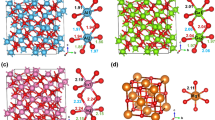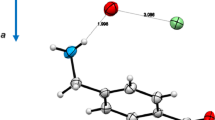Abstract
A density functional theory and wave function theory investigation on the possibility of carbon-free phosphametallocenes [P3MP3]2− and arsenametallocenes [As3MAs3]2− (M=Ni, Pd, Pt) is presented in this work. Staggered singlet D3d [E3ME3]2− (E=P, As)-the smallest inorganic metallocenes possible to construct-proved to be the global minima of the heptaatomic systems and may be targeted in future experiments. Cyclo-P −3 and cyclo-As −3 turned out to possess similar aromaticity to cyclo-P −5 and cyclo-As −5 and may serve as effective ligands to sandwich a wide range of transition metals. The first vertical electron detachment energies of Cs [E3ME3]Li− monoanions with a staggered [E3ME3]2− sandwich core were predicted to be between 2.7 and 2.9 eV; the extent of stabilization by Li+ suggests that such materials be viable targets for experimental characterization.
Similar content being viewed by others
References
Peruzzini M, Gonsalvi L, Romerosa A. Coordination chemistry and functionalization of white phosphorus via transition metal complexes. Chem Soc Rev, 2005, 34: 1038–1047
Johnson BP, Balazs G, Scherer M. Complexes with a metal-phosphorus triple bond. Top Curr Chem, 2004, 232: 29–41
Scherer OJ. Pn and Asn ligands: A novel chapter in the chemistry of phosphorus and arsenic. Acc Chem Res, 1999, 32:751–762
Scherer OJ. Complexes with substituent-free acyclic and cyclic phosphorus, arsenic, antimony, and bismuth ligands. Angew Chem Int Ed Engl, 1990, 29: 1104–1122
Tremel W, Hoffmann R, Kertesz M. Inorganic rings, intact and cleaved, between two metal fragments. J Am Chem Soc, 1989, 111: 2030–2039
Reddy AC, Jemmis ED, Scherer OJ, Winter R, Heckmann G, Wolmershauser G. Electronic structure of triple-decker sandwich complexes with P6 middle rings. Synthesis and X-ray structure determination of bis (η5-1,3-di-tert-butylcyclopentadienyl)(μ-η6: η5-hexaphosphorin)diniobium. Organomet, 1992, 11: 3894–3900
Scherer OJ. Small neutral Pn molecules. Angew Chem Int Ed, 2000, 39: 1029–1030
Vaira MD, Sacconi L. Transition metal complexes with cyclotriphosphorus (η3P3) and tetrahedro-tetraphosphorus (η1P4) ligands. Angew Chem Int Ed Engl, 1982, 21: 330–342
Hitchcock PB, Nixon JF, Natos RM. Tri-, penta-, and hexa-phospha ruthenocenes. J Organometal Chem, 1995, 490: 155–162
Seidel WW, Summerscales OT, Patrick BO, Fryzuk MD. Activation of white phosphorus by reduction in the presence of a zirconium diamidodiphosphine macrocycle: formation of a bridging squareplanar cyclo-P4 unit. Angew Chem Int Ed, 2009, 48: 115–117
Kraus F, Aschenbrenner JC, Korber N. P 2−4 : A 6π aromatic polyphosphide in dicesium cyclotetraphosphide-ammonia. Angew Chem Int Ed, 2003, 42: 4030–4033
Lynam JM. New routes for the functionalization of P4. Angew Chem Int Ed, 2008, 47: 831–833
Vaira MD, Midollini S, Sacconi L. Cyclo-triphosphorus and cyclo-triarsenic as ligands in “double sandwich” complexes of cobalt and nickel. J Am Chem Soc, 1979, 101: 1757–1763
Urnezius E, Brennessel WW, Cramer CJ, Ellis JE, Schleyer PvR. A carbon-free sandwich complex [(P5)2Ti]2−. Science, 2002, 295: 832–834
Li Z, Zhao C, Chen L. Sandwich complexes of the P 2−4 aromatic ring with the first row transition metal. J Mol Struct (THEOCHEM), 2007, 810: 1–6
Burdett JK, Marsden CJ. New J Chem, 1988, 12: 797
Hamilton TP, Schaefer IIIHF. The triphosphorus anion (P −3 ): A near degeneracy between equilateral triplet and linear singlet electronic states. Chem Phys Lett, 1990, 166: 303–306
Haser M. Structural rules of phosphorus. J Am Chem Soc, 1994, 116: 6925–6926
Jones RO, Gantefor G, Hunsicker S, Pieperhoff P. Structure and spectroscopy of phosphorus cluster anions: theory (simulated annealing) and experiment (photoelectron detachment). J Chem Phys, 1995, 103: 9549–9562
Becke AD. Density-functional thermochemistry. III. The role of exact exchange. J Chem Phys, 1993, 98: 5648–5652
Lee C, Yang W, Parr RG. Development of the Colle-Salvetti correlation-energy formula into a functional of the electron density. Phys Rev B, 1988, 37: 785–789
Burke K, Perdew JP, Wang Y. In: Dobson J F, Vignale G, Das M P, eds. Electronic Density Functional Theory: Recent Progress and New Directions. New York: Plenum, 1998
Perdew JP, Burke K, Wang Y. Generalized gradient approximation for the exchange-correlation hole of a many-electron system. Phys Rev B, 1996, 54: 16533–16539
Frisch MJ, Trucks GW, Schlegel HB, Scuseria GE, Robb MA, Cheeseman JR, Montgomery JA Jr, Vreven T, Kudin KN, Burant JC, Millam JM, Iyengar SS, Tomasi J, Barone V, Mennucci B, Cossi M, Scalmani G, Rega N, Petersson GA, Nakatsuji H, Hada M, Ehara M, Toyota K, Fukuda R, Hasegawa J, Ishida M, Nakajima T, Honda Y, Kitao O, Nakai H, Klene M, Li X, Knox JE, Hratchian HP, Cross JB, Adamo C, Jaramillo J, Gomperts R, Stratmann RE, Yazyev O, Austin AJ, Cammi R, Pomelli C, Ochterski JW, Ayala PY, Morokuma K, Voth GA, Salvador P, Dannenberg JJ, Zakrzewski VG, Dapprich S, Daniels AD, Strain MC, Farkas O, Malick DK, Rabuck AD, Raghavachari K, Foresman JB, Ortiz JV, Cui Q, Baboul AG, Clifford S, Cioslowski J, Stefanov BB, Liu G, Liashenko A, Piskorz P, Ko-maromi I, Martin RL, Fox DJ, Keith T, Al-Laham MA, Peng CY, Nanayakkara A, Challacombe M, Gill P MW, Johnson B, Chen W, Wong MW, Gonzalez C, Pople JA. Gaussian 03, revision, A. 1. Pittsburgh: Gaussian, Inc., 2003
Scuseria GE, Schaefer HF. Is coupled cluster singles and doubles (CCSD) more computationally intensive than quadratic configuration interaction (QCISD)? J Chem Phys, 1989, 90: 3700–3703
Schleyer PvR, Maerker C, Dransfeld A, Jiao H, Hommes NJvE. Nucleus-independent chemical shifts: A simple and efficient aromaticity probe. J Am Chem Soc, 1996, 118: 6317–6318
Stuttgart RSC 1997 ECP basis sets used in this work and the related references therein can be obtained from https://bse.pnl.gov/bse/portal
Martin JML, Sundermann A. Correlation consistent valence basis sets for use with the Stuttgart-Dresden-Bonn relativistic effective core potentials: The atoms Ga-Kr and In-Xe. J Chem Phys, 2001, 114: 3408–3420
Alexandrova AN, Boldyrev AI. Search for the Li 0/+1/−1n (n = 5–7) lowest-energy structures using the ab initio gradient embedded genetic algorithm (GEGA). Elucidation of the chemical bonding in the lithium clusters. J Chem Theory Comput, 2005, 1: 566–580
Scherer OJ, Braun J, Wolmershauser G. Nickelapnicogencubane. Chem Ber, 1990, 123: 471–475
Scherer OJ, Dave T, Braun J, Wolmershauser G. Nickelkomplexe mit P −x liganden. J Organomet Chem, 1988, 350: C20–C24
Zhao S. Study of the chemical bond in crystals III NiAs type compounds. Acta Sci Nat Univ Pekin, 1992, 28: 394–398
Exner K, Schleyer PvR. Planar hexacoordinate carbon: A viable possibility. Science, 2000, 290: 1937–1940
Li X, Kuznetsov AE, Zhang HF, Boldyrev AI, Wang LS. Observation of all-metal aromatic molecules. Science, 2001, 291: 859–861
Author information
Authors and Affiliations
Corresponding author
Additional information
This work was supported by the National Natural Science Foundation of China (Grant No. 20873117).
Electronic supplementary material
Rights and permissions
About this article
Cite this article
Miao, C., Chen, Q., Guo, J. et al. Carbon-free D3d [E3ME3]2− (E=P, As; M=Ni, Pd, Pt): The smallest inorganic sandwich complexes with aromatic η3-P −3 and η3-As −3 ligands. Sci. China Chem. 53, 940–944 (2010). https://doi.org/10.1007/s11426-010-0116-x
Received:
Accepted:
Published:
Issue Date:
DOI: https://doi.org/10.1007/s11426-010-0116-x




